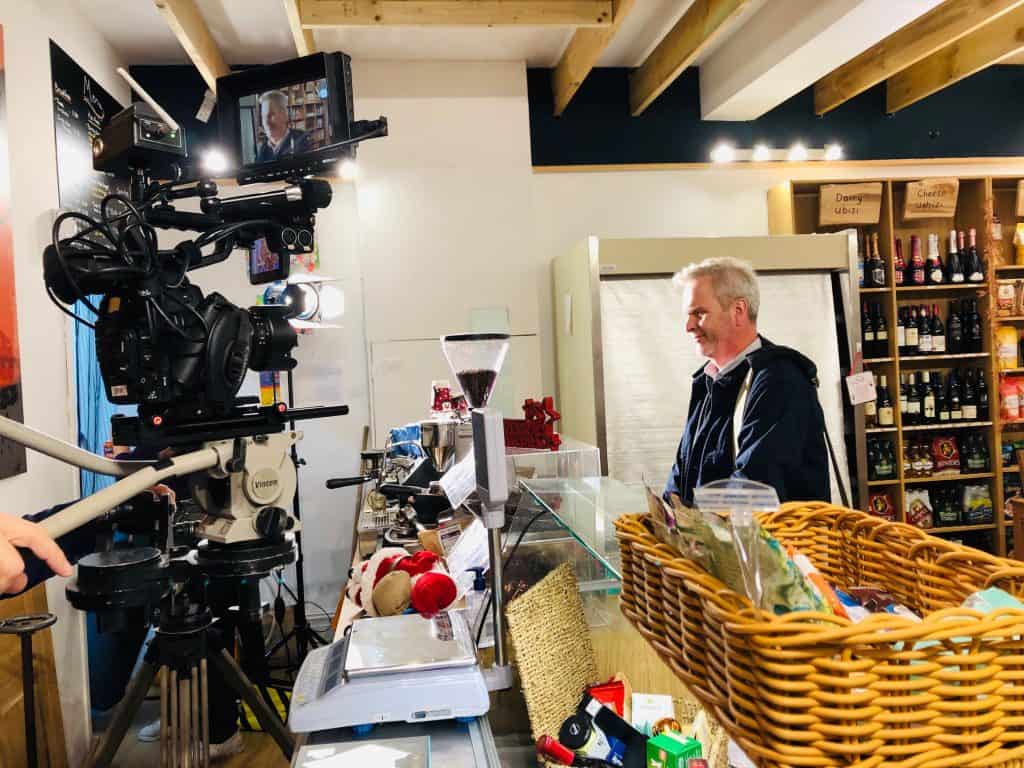Running a small business can feel like an endless cycle of trying to attract new customers, keep current ones happy, and stand out in a crowded marketplace. If you’ve ever felt this way, you’re not alone. The good news is that there’s a tool that can help with video marketing. Video isn’t just for big brands with huge budgets; it’s a powerful way for any small business to engage with customers and grow.
In this article, we’ll explore why video is such a game-changer for small businesses, how you can start using business video effectively, and what types of videos might be perfect for your business. Think of this as a guide to understanding how video can help your small business not just survive, but thrive.

But more, we will give you a FREE Video Marketing Strategy Blueprint for you to use to clarify what you need to do to get this boost for your business.
The Growth of Video Marketing
It’s impossible to miss how popular video has become. From YouTube to TikTok, people love watching videos. In fact, research shows that people spend more time watching online videos than ever before. And this isn’t just for entertainment. Consumers turn to video to learn about products, services, and companies.
For small businesses, this presents an exciting opportunity. Video lets you show, not just tell, what your business is about. Whether it’s demonstrating how your product works, introducing your team, or sharing a customer’s success story, video makes your message more personal and engaging.
Why Video is a Must for Small Businesses
1. Building Trust and Showing the Human Side of Your Business
People like to do business with companies they trust. But as a small business, how do you build that trust? Video is an excellent way to connect with customers in a more personal and human way. Imagine a potential customer visiting your website or social media page and seeing a video where you introduce yourself, explain what makes your business unique, or show a satisfied customer using your product or service. That personal touch can make all the difference.
For example, let’s say you own a small bakery. A short video showing how you bake your cakes, where you source your ingredients, and a glimpse into the love and care you put into your work can make your business feel more relatable and trustworthy. It’s not just about the product, you’re telling a story that connects with your audience.
2. Keeping Your Audience Engaged
Getting and keeping people’s attention is tough. With so much content out there, it’s easy for your message to get lost. But video can grab attention in ways other content types simply can’t. It’s engaging, visual, and can convey a lot of information quickly.
Think about how you scroll through social media. When a video catches your eye, you’re more likely to stop and watch, right? That’s why video is so effective, it’s naturally attention-grabbing. Whether it’s a quick tip, a behind-the-scenes look at your process, or a message from a happy customer, videos can draw people in and keep them interested longer than text or static images.
3. Boosting Your Website’s Visibility on Google
You’ve probably heard the term SEO (Search Engine Optimisation), which is the practice of improving your website so it appears higher in search engine results. What you might not know is that Google loves video content. Websites with videos tend to rank higher because video keeps people on your site longer, showing Google that your content is valuable.
Let’s say you run a small fitness studio. Posting a video tutorial on simple at-home exercises doesn’t just show your expertise, it can also improve your ranking in search results. Plus, videos can appear in Google’s “Video” search results, giving you an extra chance to be found by potential customers.
4. Making Video Affordable and Easy
One common misconception about video marketing is that it’s expensive and difficult to create. While high-end videos with large production crews can be costly, you don’t need to take that route to get effective results. At KindFame Productions, we specialise in offering cost-effective video solutions tailored to small businesses, ensuring that you get high-quality content without breaking the bank.
We understand that small businesses often work within tight budgets, which is why we provide flexible options that fit your needs. Whether you want a polished, professional video or a simpler production, we can help. Our team works with the latest tools and techniques, making it easy to create content that looks great and engages your audience.
For example, if you own a local boutique, we can help you create a professional-looking video that showcases your latest arrivals or a Q&A session where you answer customer questions about your products. With KindFame Productions, you can create videos that help promote your business, without the hefty price tag.

5. Supercharging Your Social Media Efforts
Social media platforms love video. Facebook, Instagram, and TikTok all prioritise video content, meaning your posts are more likely to be seen if they include video. Even better, videos tend to get more likes, comments, and shares than other types of posts, which helps increase your reach.
Let’s say you run a beauty salon. A video of a hair transformation or makeup tutorial can show off your skills while engaging your audience. You could even host a live Q&A session where followers can ask questions in real-time. Videos like these help you build a loyal online following and keep your business top of mind.
Types of Videos Small Businesses Can Create
Now that you see why video is important, what kinds of videos should you create? Here are a few ideas that work well for small businesses:
1. Explainer Videos
An explainer video does just what it sounds like, it explains something. This could be how your product works, how your service helps customers, or even what sets your business apart. These videos are typically short and clear, helping potential customers understand why they should choose you.

2. Product Demos
If your small business sells products, a demo video can be a great way to show customers exactly what they’re getting. You can highlight features, demonstrate how the product works, and explain its benefits. This works well for businesses like online shops or those offering physical goods.
3. Customer Testimonials
Nothing builds trust like hearing from a satisfied customer. A video testimonial lets your current customers share their positive experiences in their own words. This is especially powerful because potential customers trust other people’s opinions more than advertising.
4. Behind-the-Scenes Videos
People love getting a sneak peek behind the curtain. A behind-the-scenes video shows customers what goes into running your business, whether it’s how your product is made, what your office looks like, or a day in the life of your team. This kind of video helps humanise your brand and make you more relatable.
5. How-To and Tutorial Videos
People love learning new things, and a tutorial video can be a great way to showcase your expertise. If you run a small bakery, you could create a video on how to bake the perfect cupcake. If you own a garden center, a video on planting tips could be a hit. Tutorials provide value to your audience while also showcasing your knowledge.

6. Live Videos
Live videos are another way to engage with your audience. Platforms like Facebook and Instagram allow you to stream live, giving you a chance to interact with your followers in real-time. You could host a live Q&A, show off a new product, or even broadcast an event. The immediacy of live video creates a sense of connection that’s hard to match with other types of content.
Getting Started with Video Marketing
Ready to give video a try? Here’s how to get started without feeling overwhelmed.
1. Set Clear Goals
What do you want to achieve with your videos? Whether it’s building brand awareness, driving sales, or educating your customers, having a clear goal will help guide the type of content you create.
2. Start Small
You don’t need to create a Hollywood-level production right away. Start with simple videos that show off your product, introduce your team, or share a customer testimonial. As you get more comfortable, you can experiment with more complex videos.
3. Use Your Smartphone
You don’t need expensive equipment to make good videos. Modern smartphones have excellent cameras, and with a few basic tools (like a tripod and a good microphone), you can create videos that look and sound professional.
4. Promote Your Videos
Once your video is ready, share it everywhere; on your website, social media, in emails, and more. The more places people can see it, the better chance it has of reaching your audience.
5. Be Consistent
The key to video marketing is consistency. Try to create and share videos regularly, whether it’s once a week or once a month. The more video content you produce, the more opportunities you have to connect with your audience.
Develop Your Perfect Video Marketing Strategy with Our Blueprint
If you’re a small business owner looking to harness the power of video to grow your business, our Video Marketing Strategy Blueprint is the perfect starting point. This easy-to-follow questionnaire is designed to guide you step by step through the process of creating a video marketing strategy tailored to your specific goals, audience, and resources. Whether you’re new to video or looking to improve your existing efforts, this blueprint will help you gain clarity and develop a clear action plan.
Download you FREE Video Marketing Strategy Blueprint Here.
What Is the Blueprint?
The blueprint is a structured questionnaire that covers all the critical areas you need to consider when developing a video marketing strategy. It breaks down the process into manageable sections, each focusing on a key part of your strategy. By answering these questions, you’ll gain insights into your business goals, target audience, types of videos to create, how to budget for video production, and how to measure success.
The blueprint will:
- Simplify the video marketing planning process.
- Clarify your business goals and target audience.
- Help you identify the best types of video content to create.
- Provide guidance on budgeting and production tools.
- Assist in measuring and optimising your video marketing efforts over time.

Let’s go through each category in the blueprint and how it will help you create a useful video marketing strategy.
1. Define Your Business Goals
This category helps you get clear on what you want to achieve with your video marketing efforts. Are you trying to build brand awareness, drive sales, or educate customers about your products or services? Knowing your primary goal will shape your entire video marketing strategy, ensuring that every video you create serves a purpose and delivers results.
Why it’s important: Setting clear goals provides focus and direction. It helps ensure that your videos align with your broader business objectives.
2. Understand Your Audience
It’s essential to know who you’re speaking to with your videos. This section helps you identify your target audience, their interests, pain points, and how they prefer to consume video content. This knowledge allows you to tailor your messaging and style to resonate with the right people.
Why it’s important: Understanding your audience ensures that your video content is relevant and compelling, which increases engagement and the likelihood of converting viewers into customers.
3. Determine Your Video Types
Once you know your goals and audience, it’s time to think about what kind of videos to create. This section helps you choose between product demos, customer testimonials, educational videos, or behind-the-scenes content. You’ll also consider the tone and style of your videos to match your brand’s personality.
Why it’s important: Different types of videos serve different purposes. For example, a product demo may help explain your product’s benefits, while a customer testimonial builds trust. Selecting the right type of video is key to achieving your goals.
4. Set Your Budget and Resources
Video production doesn’t have to break the bank. This section guides you in setting a realistic budget based on your resources and the type of videos you want to create. It also covers what tools you might need, whether it’s a smartphone and tripod for DIY videos or hiring a freelance videographer for more polished productions.
Why it’s important: Knowing your budget upfront allows you to plan realistically. It also helps you determine what’s achievable with the resources you have, ensuring that you make the most out of your investment in video marketing.
5. Create a Content Calendar
Consistency is key when it comes to video marketing. This section helps you plan how often you’ll create and post videos, along with mapping out specific topics or themes for each video. A content calendar ensures that you stay organised and on track, so your audience knows when to expect new content.
Why it’s important: A content calendar keeps your video strategy consistent, helping you build momentum and engagement with your audience over time. It also ensures that you’re delivering fresh, timely content that aligns with your business goals.
6. Optimise for Search and Engagement
This section walks you through the basics of optimising your videos for search engines (SEO) and making them as engaging as possible. You’ll think about what keywords to use in your video titles and descriptions, how to craft compelling calls-to-action (CTAs), and whether to add subtitles or closed captions for accessibility and better rankings.
Why it’s important: Optimising your videos helps more people find them through search, while engagement strategies encourage viewers to take action, whether that’s liking, sharing, or visiting your website.
7. Track and Measure Your Success
Once your videos are live, it’s crucial to measure how well they’re performing. This section helps you identify the key metrics to track, such as views, engagement, and conversions. By reviewing these numbers regularly, you can adjust your strategy to improve results.
Why it’s important: Measuring success helps you understand what’s working and what’s not. It ensures that your efforts are paying off and helps you fine-tune your strategy over time to maximise impact.
8. Plan for Long-Term Success
The final section of the blueprint helps you look ahead and plan for the future. You’ll think about long-term goals for your video marketing, whether it’s expanding your content or scaling up production as your business grows. This section encourages you to think strategically and plan for sustainable growth.
Why it’s important: Video marketing is a long-term investment. Planning for the future ensures that your strategy can grow with your business and continue delivering value over time.
How to Use the Blueprint
Download you FREE Video Marketing Strategy Blueprint Here.
- Download or print the blueprint to keep it handy as you work through each section.
- Answer the questions thoughtfully, considering your business’s unique needs, resources, and audience.
- Use the answers to create a comprehensive video marketing plan that aligns with your business goals.
- Review the blueprint regularly to ensure your strategy stays relevant as your business grows and market conditions change.
By using this blueprint, you’ll have a solid foundation for creating videos that resonate with your audience, showcase your business, and drive meaningful results. Whether you’re a beginner or looking to enhance your existing efforts, this step-by-step guide will help you stay focused and organised, leading to a more successful video marketing strategy.
Conclusion
Video marketing is an incredibly powerful tool for small businesses. It helps build trust, engages your audience, improves your website’s visibility, and can be done affordably and easily. Whether you’re creating product demos, customer testimonials, or behind-the-scenes content, video allows you to show the heart and soul of your business in a way that resonates with your customers.
So, if you haven’t started using video in your marketing strategy, now is the time. Start small, experiment, and watch as video helps your business grow and connect with customers in new and meaningful ways.
Contents
- 1 The Growth of Video Marketing
- 2 Getting Started with Video Marketing
- 3 Develop Your Perfect Video Marketing Strategy with Our Blueprint
- 3.1 What Is the Blueprint?
- 3.2 1. Define Your Business Goals
- 3.3 2. Understand Your Audience
- 3.4 3. Determine Your Video Types
- 3.5 4. Set Your Budget and Resources
- 3.6 5. Create a Content Calendar
- 3.7 6. Optimise for Search and Engagement
- 3.8 7. Track and Measure Your Success
- 3.9 8. Plan for Long-Term Success
- 3.10 How to Use the Blueprint
- 4 Conclusion

